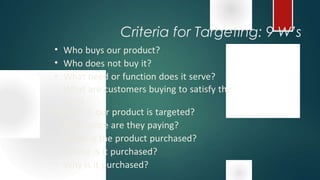STP
- 1. THE BREAKING DOWN OR BUILDING UP OF POTENTIAL BUYERS INTO GROUPS CALLED MARKET SEGMENTS What is Market Segmentation?
- 2. STP It is the Research that determine how your organization divides its customers into smaller groups based on age,income,personality traits and behaviour It Creates Subsets of Marketing based on Demographic Needs,priorities,common interest,phychographic or behavioural critirea that is used to understand demands of targeted Audience Marketing Segmentaion is the Process of identifying and breaking up the total market into groups of potential customers with similar motivations, needs or characteristics, who are likely to exhibit homogeneous purchase behaviour.
- 3. Benefits of Market Segmentation Identifies opportunities for new product development Helps design marketing programs most effective for reaching homogenous groups of buyers Improves allocation of marketing resources
- 4. Bases for segmentation in consumer markets Geographic Demographic Psychographic Behavioralistic
- 5. Geographical Segmentation Geographical Segmentation-It tries to divide customers according to different geographica; boundaries or groups such as regions,size of area,population density,climate Understanding Climate and geographical regions helps determine where to Sell,advertise as well as expand business Geographic segmentation tries to divide markets into different geographical units: Regions Size of the area Population density Climate
- 6. Geographic segmentation Regions: by continent, country, state or even neighborhood Size of the area: segmented according to size of population Population density: often classified as urban, suburban, or rural
- 7. Demographic segmentation Demographic segmentation consists of dividing the market into groups based on variables such as: • Age • Gender • Income Gender: Gender segmentation is widely used in consumer marketing. The best examples include clothing, hairdressing, magazines and toiletries and cosmetics. • Social class • Life style
- 8. Age : Marketers design, package and promote products differently to meet the wants of different age groups. Good examples include the marketing of toothpaste (contrast the branding of toothpaste for children and adults) and toys (with many age-based segments). Social class: Consumers "perceived" social class influences their preferences for cars, clothes, home furnishings, leisure activities and other products & services. Income: Many companies target affluent consumers with luxury goods and convenience services. Good examples include Coutts bank; Moet & Chandon champagne and Elegant Resorts - an up-market travel company. Demographic segmentation
- 9. Psychographic segmentation Psychographic segmentation groups customers according to their lifestyle. Activities, interest, and opinions (AIO) surveys are one tool for measuring lifestyle. Activities Interest Opinion Values
- 10. Behavioralistic segmentation Behavioralistic segmentation is based on actual customer behavior towards products. Some behavioralistic variable include: Opinions, interests and hobbies Degree of loyalty Occasions Benefits sought Usage
- 11. Degree of loyalty – customers who buy one brand either all or most of the time are valuable to firms. Occasions – this segments on the basis of when a product is purchased or consumed. Opinions, interests and hobbies – this covers a huge area and includes consumers’ political opinions, views on the environment, sporting and recreational activities and arts and cultural issues. Behavioralistic segmentation
- 12. Target Marketing • Target Market – Consists of a set of buyers who share common needs or characteristics that the company decides to serve. – The process of evaluating segments and focusing marketing efforts on a country, region, or group of people that has significant potential to respond
- 13. Criteria for Targeting: 9 W’s • Who buys our product? • Who does not buy it? • What need or function does it serve? • What are customers buying to satisfy the need for which our product is targeted? • What price are they paying? • When is the product purchased? • Where is it purchased? • Why is it purchased?
- 14. • Selecting Target Market Segments – Undifferentiated (mass) marketing (A company’s attempt to appeal to the whole market with a single basic marketing strategy intended to have a mass appeal.) (e.g., gasoline, soft drinks, white bread), the undifferentiated market approach makes the most sense. Differentiated (segmented) marketing – (a company’s attempt to appeal to two or more well defined market segments with a marketing strategy tailored to each segment)
- 15. Concentrated (niche) marketing – (a company’s attempt to appeal to one well defined market segment with one tailor made marketing strategy.) For example, selling auto parts only to auto manufacturers is a concentrated marketing strategy. – Micromarketing (local or individual)-Offering products or services that meet unique needs of individuals. Examples are Relationships,Job Title, Industry,Size
- 16. Positionin g is the act the o f designin gcompany’s offering and image to occupy a distinctive place in the target market’s mind. Market positioning-refers to the consumer's perception of a brand or product in relation to competing brands or products.Market positioning refers to the process of establishing the image or identity of a brand or product so that consumers perceive it in a certain way.
- 17. Developing and communicating a positioning strategy • Superior : The difference is superior to other ways of obtaining the benefit. • Preemptive : The difference cannot be easily copied by competitors. • Affordable : The buyer can afford to pay for the difference. • Profitable : The company will find it profitable to introduce the difference.
- 18. Steps to Choosing and Implementing a Positioning Strategy • Step 1. Identifying a set of possible competitive advantages: Competitive Differentiation. • Step 2. Selecting the right competitive advantage. • Step 3. Effectively communicating and delivering the chosen position to the market.
- 19. EXAMPLES
- 20. Some examples
- 21. PPT ON STP BY JASJEET SINGH PGDM 3SEM MOS (MARKETING OF SERVICES)





















